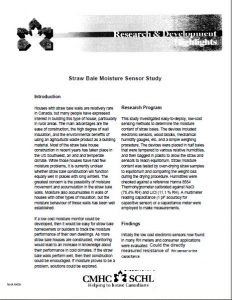
Houses with straw bale walls are relatively rare in Canada, but many people have expressed interest in building this type of house, particularly in rural areas. The main advantages are the ease of construction, the high degree of wall insulation, and the environmental benefits of using an agricultural waste product as a building material. Most of the straw bale house construction in recent years has taken place in the US Southwest, an arid and temperate climate. While those houses have had few moisture problems, it is currently unclear whether straw bale construction will function equally well in places with long winters. The
greatest concern is the possibility of moisture movement and accumulation in the straw bale walls. Moisture also accumulates in walls of houses with other types of insulation, but the moisture behaviour of those walls has been well established. If a low cost moisture monitor could be developed, then it would be easy for straw bale homeowners or builders to track the moisture performance of their own dwellings. As more straw bale houses are constructed, monitoring would lead to an increase in knowledge about their performance in cold climates. If the straw bale walls perform well, then their construction could be encouraged. If moisture proves to be a problem, solutions could be explored.
Autor: Don Fugler, The Canadian Housing Information Center



